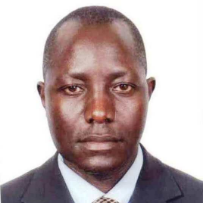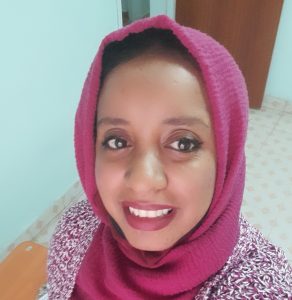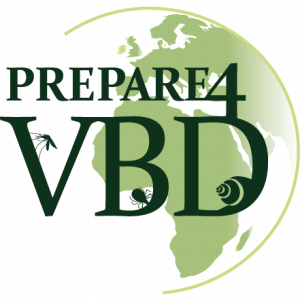Fellows
PREPARE4VBD early career researchers
Postdoctoral Fellows

Mokgadi Pulane Malatji
School of Life Sciences, College of Agriculture, Engineering and Science, University of KwaZulu-Natal, Durban, South Africa
Topic: Spatial distribution and genetic diversity of Fasciola hepatica and Fasciola gigantica and their intermediate hosts in South Africa
My research focuses on mapping the spatial distribution of both Fasciola hepatica and Fasciola gigantica and their intermediate hosts in South Africa. This will also include identifying, barcoding, and further assess the genetic diversity within and between Fasciola species from various provinces of South Africa. Furthermore, determine the potential risk factors contributing to the dissemination of fascioliasis. We will also identify and study population genetic structure of the snail IHs (Lymnaeidae) implicated in the distribution of Fasciola species in South Africa. Furthermore, determine their geographical expansion and environmental conditions that are associated with their occurrence, linking them to the occurrence of Fasciola species. Then, assess the role played by these snail species in the spread of Fasciola species by assessing natural infection of lymnaeid species with Fasciola species. The project is mainly related to PREPARE4VBD WP6
 Thomas Démoulins
Thomas Démoulins
Institute of Veterinary Bacteriology, Vetsuisse Faculty – University of Bern, Switzerland
Topic: Disease susceptibility of European and African cattle breeds
Our working hypothesis is that different livestock breeds show different susceptibilities to specific infectious diseases due to different responses of their immune cells. We will build an ex vivo laboratory platform using peripheral blood mononuclear cells (PBMCs) collected from cattle with a different genetic background, namely Bos taurus versus Bos indicus cattle. PBMCs will be stimulated with several vector borne disease (VBD)-causing pathogens (bovine-specific bacterial and viral VBD). Independent experimental readouts will be analyzed to investigate the aforementioned PBMC responses: i) multiparameter flow cytometry (FCM) assays, to measure the activation, maturation and proliferation state of the individual immune cell subsets (monocytes, cDCs, pDCs, NK cells, γδ T cells, B and T cells), as well as the cytokine and chemokine level produced intracellularly; ii) Luminex-type based bead assays, to monitor chemokine and cytokine levels produced in the PBMC supernatant. In a second step, we will correlate the different immune responses observed between Bos taurus versus Bos indicus cattle via bulk RNA sequencing with their different genetic backgrounds, recorded by whole genome sequencing. Finally, the two bovine vector-borne pathogens showing the most differences will be employed for a new set of experiments involving PBMC stimulation. The resulting single-cell RNA sequencing (scRNA-seq) analysis will allow a better understanding of the precise role of all individual immune cell subsets and their specific Bos indicus- or Bos taurus-related genes. Finally, we will be able to predict diseases susceptibilities based on immune responses monitored in blood-based ex vivo systems.
 Joost Verhoeven
Joost Verhoeven
GLOBE Institute – University of Copenhagen, Denmark
Topic: Interactions between tick microbiome and vector adaptive capacity
The major throughline of my research focuses on elucidating the interactions between ticks, their microbiome, and vector adaptive capacity. By examining the tick microbiome, including pathogens, we hope to uncover the underlying mechanisms that form microbial assemblages in ticks, and how these mechanisms and microbiomes can vary over climate and geography. Through this data we aim to provide new insights into the potential adaptive capacity of tick vectors to harbor specific pathogens and how microbiomes affect the competence for transmitting diseases.
PhD Fellows
 Abel Wilson Walekhwa
Abel Wilson Walekhwa
Makerere University, Kampala and Uganda
Topic: Ecological niche modelling of Rift Valley fever disease transmission in selected districts in Uganda
In my PhD study, I intend to; (1) to describe the epidemiological characteristics of RVF outbreaks in Uganda for 2000-2021, (2) to profile the clinical presentation of RVF in selected species (3) to build an ecological niche model for next RVF outbreaks in Uganda, (4) to build a model for a one health cost effective intervention suitable for Uganda in mitigating RVF outbreaks. Rift valley fever disease (RVF) is a zoonotic infectious viral disease of both humans, livestock and wildlife. In humans it manifests as mild-flu, severe hemorrhagic fever, death. Uganda has reported sporadic outbreaks of RVF since 2016 and these are almost becoming endemic with recent outbreak reported in January 2022 in Kagadi district, Western Uganda. This study aligns to work Package 2, 3 and 9 in the PREPARE4VBD project. The outputs from study will be RVF Risk models for Ugandan context, promotion of predictive approaches to disease outbreaks than reactive approach where countries struggle to respond to a disease after it has occurred. This project will also suggest cost effective one health approaches in the mitigation of future RVF outbreaks through efforts like RVF Vaccination in Uganda.
 Adriko Moses
Adriko Moses
Vector Borne & Neglected Tropical Disease Control Division, Ministry of Health, Uganda/ Makerere University, Kampala, Uganda
Topic: Spatio-temporal epidemiology of human-animal fascioliasis and other bovine trematodes and vector snails in different agro-ecological settings in Uganda.
The aim of the PhD project is to investigate the epidemiology of zoonotic and bovine trematodes and vector snails species, with a focus on Fasciola species and to some extent Schistosoma bovis and their infections in animals (cattle) in three different agro-ecological transmission settings in Uganda: Lake Victoria, Lake Kyoga and Lake Albert. It will also investigate the knowledge, attitudes and practices (KAP) in prevention and control of Fascioliasis amongst livestock farmers along the same transmission areas in Uganda. The project will also compare diagnostic accuracy and usefulness between tools and methods developed and deployed in PREPARE4VBD. The project is mainly related to WP6 in PREPARE4VBD.
 Alexandros Angelakis
Alexandros Angelakis
Swiss Tropical and Public Health Institute, Switzerland
Topic: Model-based surveillance for Rift Valley Fever (RVF)
The focus of my PhD study is to develop methodology for strengthening model-based surveillance for Rift Valley Fever (RVF). Stochastic, compartmental metapopulation models will be developed, which take into account the disease dynamics, seasonality and spatial interactions. These models will be used to detect the onset of outbreaks prospectively, to obtain short-term forecast of disease incidence and assess intervention scenarios. This project is mainly related to PREPARE4VBD WP7.
 Dennis Getange
Dennis Getange
International Centre of Insect Physiology and Ecology (icipe), Kenya
Topic: Unravelling the determinants of arthropod vectors (tick and mosquito) microbiome composition using the omics approaches
The main focus of this PhD is to characterize the bacterial community of ticks (collected from livestock and vegetation) and mosquitoes in Kenya and the factors that shape their microbiome composition. We will characterize the microbiota profiles of reproductive organs, midgut (MD) and salivary glands of livestock and field-collected ticks in Shimba Hills and Marsabit county in Kenya and also study the impact of biotic and abiotic factors on microbiome composition in tick vectors (a) similarities and differences in livestock collected and wild-caught tick populations, b) effect of host-blood meal on tick microbiome, and c) difference in microbiome based on location, temperature and soil moisture. The study will also investigate the role of mosquitoes in transmission of rickettsiales bacteria and determine temporal patterns of richness and evenness in microbial communities in wild-caught mosquitoes.

Dube Agrippa
University of KwaZulu-Natal, South Africa
Topic: Determination of the effect of temperature on fascioliasis transmission.
The aim of my study is to determine the effect of temperature on Lymnaea-Fasciola interactions. The specific objectives of my study are to determine the effect of temperature on the growth rate, fecundity and survival of uninfected and infected Galba truncatula and Radix natalensis snails. Furthermore to determine the effect of temperature on the egg hatchability and the survival rate of the miracidium and to determine the effect of temperature on host cercariae shedding and the survival rate of metacercariae. Field collected snails in KwaZulu-Natal province, South Africa will be bred in the laboratory and followed by temperature manipulations to both infected and uninfected lymnaea snails. The data from the laboratory and field work will be combined to create a mechanistic model to forecast future fasciolosis transmission dynamics and provide information on the distribution of various host snail species in a specific region. From this potential disease hotspots can be identified in the future and research institutes can utilize the data from this study for educational purposes. The information can be used in disease awareness campaigns. My project mainly relates to PREPARE4VBD WP6.

Ignore Nyagura
School of Life Sciences, College of Agriculture, Engineering and Science, University of KwaZulu-Natal, Durban, South Africa
Topic: Impact of climatic, human-related activities and environmental factors on the distribution of Lymnaeid snails and Fasciola species transmission in South Africa.
The main goal of my PhD study is to investigate the impact of climatic, human-related activities, and environmental factors on the distribution of Lymnaeid snails and Fasciola species transmission in South Africa’s endemic regions. Samples will be collected from Limpopo (Tzaneen, Musina, Polokwane), KwaZulu-Natal (uMkhanyakude, Durban), Free State, and Eastern Cape (Mthatha) provinces of South Africa. Samples will be collected twice a year, during the cold dry season and the warm rainy season. Collected samples and parasites will be preserved following standard protocols. My project mainly relates to PREPARE4VBD WP6, but also WP3.

N’DRI Kouassi Kan Nestor
University Alassane Ouattara, Bouaké, Côte d’Ivoire, Centre Suisse de Recherches scientifiques en Côte d’Ivoire, Abidjan, Côte d’Ivoire
Topic: Combined socio-ecological innovations for change in NTDs control in Africa: Barriers and facilitators of implementation
My PhD title is Combined socio-ecological innovations for change in NTDs control in Africa: Barriers and facilitators of implementation. Some VBDs are over-researched whereas others receive hardly any attention and have been grouped among neglected tropical diseases (NTDs). However, there is a lot of evidence for the control and elimination of NTDs. Cost-effective tools and elimination experiences exist in many countries in Asia, America, and Europe. However, in health systems (in Africa), it seems that NTDs receive less attention and resources. Our working hypothesis is that socioecological dynamics hinder control efforts to eliminate NTDs at several levels (research-to-policy translation, decision-making, implementation in services and communities). Therefore, this study aims to investigate obstacles and facilitators for taking research innovations to the end user.

Ngcamphalala Philile
University of KwaZulu-Natal, South Africa
Topic: Competence of lymnaeid snails as intermediate hosts of Fasciola hepatica and Fasciola gigantica in South Africa.
My project aims to determine the competence of selected lymnaeid snails as intermediate hosts of Fasciola hepatica and Fasciola gigantica in South Africa. The lymnaeid snails to be studied are the native intermediate hosts (IHs) of Fasciola spp. in South Africa: Galba truncatula (F. hepatica) and Radix natalensis (F. gigantica) and the invasive Pseudosuccinea columella which has been presumed to act as an IH for both Fasciola species in South Africa. Thus, G. truncatula will be infected with F. hepatica, R. natalensis with F. gigantica while P. columella will be infected with both Fasciola spp. This will allow for the identification of the IH that is more competent at transmitting Fasciola infections and subsequently in understanding what that means for the spread of fasciolosis in the country. This will be achieved through experimental infections of all three snail species in the laboratory. Snails will be collected across five provinces of South Africa and will be bred and reared to the desired size before infection. Experimentally infected snails will be kept and monitored for 60 days, and parameters will be taken on a daily and weekly basis. In addition to compatibility results, experimental data will lead to the development of Standard Operating procedures (SOPs) and protocols for snail breeding, infection procedures, monitoring of infected snails and detection of infections in snails. Furthermore, the overall results will add information on the role played by lymnaeid snails in the transmission of Fasciola species. Findings will also add more knowledge and understanding on lymnaeid-Fasciola interactions. This knowledge is required to support policies and decisions related to the development of control strategies of zoonotic food and water-borne infections in South Africa. My project mainly relates to PREPARE4VBD WP6.

Rua Khogali
International Centre of Insect Physiology and Ecology (icipe), Nairobi, Kenya
Topic: Tick microbiomes, endosymbionts and pathogen transmission in different agro-ecological zones in Kenya
The main aim of my PhD study is to identify correlations between camel tick microbiomes, endosymbionts, and pathogen transmission in different agro-ecological zones in Kenya. This study also aims to identify and compare tick species collected from camels and their associated tick-borne pathogens (TBPs) and endosymbionts in different counties, to better characterize the genomic diversity of common TBPs and endosymbionts and to compare the microbiomes and endosymbionts of the saliva, haemolymph, and salivary glands in different tick species. The data generated in the course of this study on tick-endosymbiont-pathogen interactions and their genomic diversity will be valuable for developing locality-specific tick-borne disease control measures. The project is mainly related to PREPARE4VBD WP3, and to some extent WP4.

Sophy Nukeri
School of Life Sciences, College of Agriculture, Engineering and Science, University of KwaZulu-Natal, Durban, South Africa
Topic: Hybridization and genetic diversity of Fasciola species in South Africa
The main aim of my PhD study is to assess hybridization and determine the genetic diversity of Fasciola species in South Africa. Fascioliasis is an important food and water borne zoonotic disease with great economic impact. It is mainly caused by the two digenean trematodes, Fasciola hepatica and F. gigantica. Geographical distribution of these species depends on their snail intermediate hosts (IHs). In areas where climatic factors allow IHs of both species to overlap, there is possibility of hybridization thus occurrence of Fasciola hybrids. Such overlaps were reported in some regions of Asia and Africa whereas Fasciola hybrids were proven in Asia. The existence of hybrid species with morphological features of both Fasciola species has caused complications when using only morphological techniques for species identification, which led to the increasing use of molecular techniques. In South Africa, there is still paucity of information on population genetics of Fasciola species. Moreover, studies have reported overlapping distribution of the two Fasciola species in some provinces of the country. However, there hasn’t been any attempt to assess the possible presence of ‘hybrids’ in SA in localities where the two species are co-endemic. In PREPARE4VBD my project relates mainly to WP6

Tiem van der Deure
University of Copenhagen, Copenhagen, Denmark
Topic: Predictive modelling of vector-borne diseases to assess the impact of climate change on disease transmission
Environmental factors including climate play a crucial role in determining the distribution of vector-borne diseases. Climate change and global environmental change will continue to alter the circumstances of vector-borne disease transmission. In temperate areas, warmer temperatures can speed up the development of parasites and facilitate the spread of vectors, increasing the risk of infection. Meanwhile, in warmer areas, the picture is less clear, since the climate might become too hot and dry to facilitate transmission. In my PhD project, I will develop state-of-the-art models of vector-borne disease transmission in order to predict the effect of a warming climate on the distribution of these diseases. I will attempt to improve on earlier modelling by using a combination of statistical and mechanistic models. The project will focus primarily on snail-borne diseases including Fasciolosis, but I also hope to be able to use my models to predict mosquito-borne and tick-borne diseases.
 Godlisten Shedrack Materu
Godlisten Shedrack Materu
National Institute for Medical Research (NIMR) Mwanza Centre and Sokoine Univeristy of Agriculture (SUA) in Tanzania.
Topic: The ecology and diversity of freshwater snails and their role in the transmission of snail borne parasites of humans and animals in different ecological zones of Tanzania
The main focus of my PhD study is to further our understanding on zoonotic schistosomiasis and fasciolasis epidemiology, eDNA diagnostic and molecular characterization of intermediate host and their parasites towards development of truly effective and locally accepted surveillance and control interventions. This PhD study will assess the community knowledge, attitudes and practices (KAP) on fascioliasis and schistosomiasis drivers, prevention and control. However we will determine the prevalence of schistosomiasis and fascioliasis in human and domesticated ruminants by coprological examination and abattoir surveys, genetic diversity and molecular characterization of schistosomiasis and fascioliasis intermediate host and their parasites, seasonal trematodes infection dynamics in snails intermediate host and validatation of environmental DNA (eDNA) method in detection and monitoring of larvae stages of trematodes borne parasites in the environment.
MSc Students

Mpumelelo Hadebe
School of Nursing and Public Health, College of Health Science, University of KwaZulu-Natal
Topic: Determining the spatial distribution and infection rate of fasciola intermediate host snails in uMgungundlovu district located in Northern KwaZulu-Natal midlands: Implications on fascioliasis transmissions.
The main focus of my research is to map the spatial distribution and natural infection rate of the invasive (Pseudosuccinea columella) and native (Radix natalensis and Galba truncatula) fasciola intermediate host snails in uMgungundlovu district. The research further assesses the nature of the co-habitation relationship between the invasive and native intermediate host snails, whether the invasive snail co-exist with the native snails or out compete them. Thereafter predicting future snail abundance with the uMgungundlovu district. My project relates to PREPARE4VBD WP6.
 Stella Nabunya
Stella Nabunya
Makerere University, Uganda
Topic: Prevalence and genetic diversity of Fasciola species in cattle along Lake Albert, Kyoga and Victoria basins in Uganda
My study aims at determining the prevalence and genetic diversity of Fasciola species in cattle along Lake Albert, Kyoga and Victoria basins in Uganda. A cross- sectional study will be conducted to determine the prevalence of Fascioliasis and genetic diversity of Fasciola species in cattle. A total of 366 cattle slaughtered at the abattoirs, slaughter houses and slaughter slabs within the districts of Hoima, Buliisa (Lake Albert basin), Jinja, Mayuge (Lake Victoria basin), and Apac and Lira (Lake Kyoga basin) will be sampled on. Fecal samples will be taken from the rectum, using sedimentation method and McMaster method, microscopic assessment of Fasciola eggs and eggs per grams will be determined respectively. Additionally, the livers will be assessed for flukes by making incision through the bile duct and the flukes will be collected. DNA will be extracted from the flukes. Using Polymerase Chain Reaction genetic diversity of the flukes will be determined by use of both nuclear single and mitochondrial genetic markers. Finally phylogenetic analysis will be done. The project is mainly related to PREPARE4VBD WP6.

